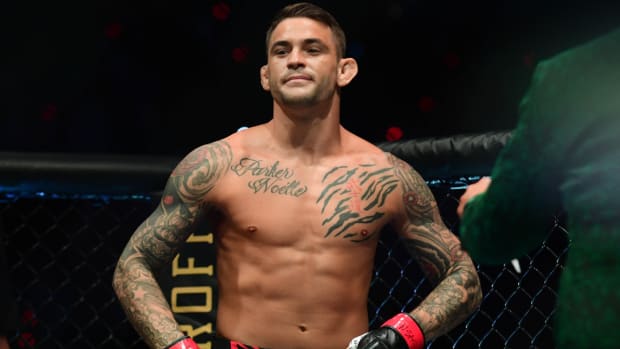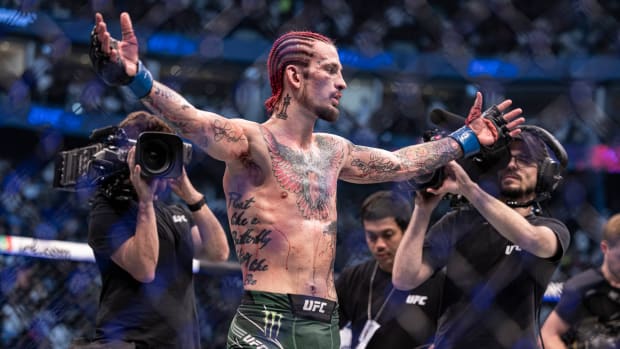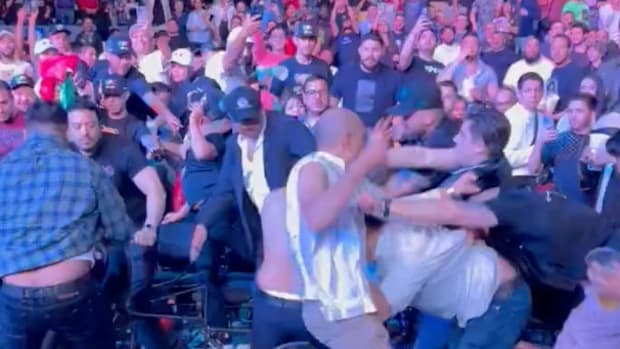A call for universal MMA rules
Watching Larry Hazzard Sr. through the chain-link fence, it was clear his discomfort intensified with each successful blow.
Inside the cage on Sept. 20, 2000, Gan McGee had just finished blasting an overmatched Canadian kickboxer when the referee assigned to work mixed martial arts' first regulated event in a major state stopped the bout. Seated cage-side inside the Tropicana Hotel and Casino on Atlantic City's rundown boardwalk, the now former New Jersey State Athletic Control Board chief turned and whispered to one of his deputies. He wasn't concerned that Brad Gabriel's evening ended with knees to the head. Rather, Hazzard wanted to discuss where McGee scored his technical knockout.
Knees to the head of a grounded fighter -- a position in which anything more than the soles of a fighter's feet touched the canvas -- had, until that night, been an accepted attack in MMA. Of course, virtually anything was legal in the earliest incarnation of the sport, but under the rules outlined by the New Jersey board, grounded knees to the cranium were as legal as a punch or a rear-naked choke. That is, until Hazzard saw them in action. (It didn't help that McGee, a 6-foot-10 training partner of Chuck Liddell, delivered the strikes on an opponent possessing limited grappling credentials.)
After Hazzard instituted what would later become known as the "Gan McGee Rule," knees aimed at a downed fighter's head were effectively outlawed in North America. Eight years later, however, the debate over which techniques should be allowed in mixed martial arts competition, including McGee's knees, remains unsettled.
Regulators are set to take another swing at the topic in the middle of 2009. The pending decision from Association of Boxing Commission members will go a long way in determining what MMA looks like decades from now, not only in terms of tactics fighters can use, but also the manner in which contests are scored.
It might seem hard to comprehend in the face of what was a staggering year at the box office, but the sport's rapid growth in the U.S. comes at a time when pockets of the country, including New York State, still call mixed-rules bouts illegal. Even in locales where it's fine to promote rules can vary, resulting in a confusing set of circumstances for mixed martial artists young and old.
The largest differences exist between what's become known as the Unified Rules of MMA in North America, and the accepted global standard.
In Japan, for instance, many of the most important fights come under a two-round format (one 10-minute period followed by a five-minute round) and bouts aren't scored under a 10-point must system. Instead, decisions are rendered with an emphasis placed on damage scored during the duration. (Incidentally, many fights allow for knees to the head on the ground, while at the same time outlawing elbows in similar positions.)
There are several major differences between the MMA we've grown accustomed to in the U.S. and Canada, and the kind many fighters are reared on outside our borders. Those differences in uniformity must be resolved. Instead of working to change rules or further limit attacks, energy should be geared toward debates over scoring and judging.
Talk of altering North American scoring standards to include half-points (say a 10-9.5 round instead of 10-9 for a tight frame) is intriguing but misguided. Mixed martial arts would be best served if regulators made sure their licensed officials were aware of the rules, aware of effective strike and submission techniques, and aware of the real value of a takedown -- all far greater factors in rendering correct decisions than providing officials, most of whom don't know what they're watching to begin with, even more options to screw up.
No one wants a return to 1995 -- no one should -- but beyond desiring scenarios that would make for a more compelling fight, there's little steam with the group of mostly hardcore fans in favor of loosening MMA rules in the States. The sport is clearly rough enough -- take a look at the results of Wednesday's injury-filled UFC card if you need evidence of that -- and it's doubtful television executives would be open to dialing up the violence quotient.
No matter where the A.B.C. comes down on McGee or judging, the sport's power brokers must look towards the future. They need to come together on rules, rounds and judges. What constitutes a championship fight in Las Vegas should be the same in Tokyo.
And if the decision is made to include knees to the head on the ground, you won't hear me complain, though its altogether possible Hazzard might want to have another conversation.




